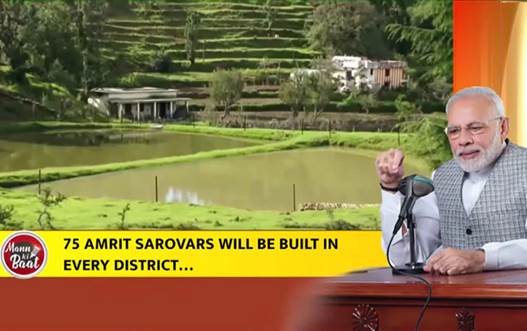Description

Copyright infringement not intended
In News
- The Union Government has completed the construction of more than 25,000 Amrit Sarovars within 6 months.
- Under Mission Amrit Sarovar, the government announced a target to build 50,000 Amrit Sarovars by 15th August 2023.
Mission Amrit Sarovar
- The Prime Minister launched a new Mission Amrit Sarovar on 24th April 2022.
- The objective of the mission is to conserve water for the future.
- The Mission is aimed at developing and rejuvenating 75 water bodies in each district of the country as a part of the celebration of Azadi ka Amrit Mahotsav.
- This Mission has been launched with a whole Government Approach in which 6 Ministries/Department namely;
- Dept of Rural Development.
- Department of land resources.
- Department of Drinking Water and Sanitation.
- Department of Water Resources.
- Ministry of Panchayati Raj.
- Ministry of Forest, Environment and Climate changes.
- The Mission works through the States and Districts, by refocusing on various schemes such as Mahatma Gandhi NREGS, 15th Finance Commission Grants, and PM Krishi Sichayi Yojana sub-schemes such as Watershed Development Component, Har Khet Ko Pani besides States’ schemes.
- The Mission would encourage the mobilization of citizen and non-govt resources for supplementing these efforts.
- The Mission Amrit Sarovar is to be completed by 15th August 2023.
- Around 50,000 such Amrit Sarovar may be constructed in the country.
- People’s participation in the Mission is the focal point.
- Local freedom fighters, their family members, Martyr’s family members, Padma Awardees and citizens of the local area wherein an Amrit Sarovar is to be constructed, will be engaged at all stages.

WATER MANAGEMENT
Need for water management
- India has nearly 17% of the World’s Population however, it holds only about 4% of Global freshwater.
- According to NITI Aayog, Almost 70% of Surface water resources are contaminated by Biological, Toxic, Organic, and inorganic Pollutants.
- 75% of the households do not have drinking water on their Premise.
- 40% of India’s population will have no access to drinking water by 2030.
- 600 million People in India face high to extreme water Stress.
- India generates around 70 billion litres of wastewater every day, which is expected to double in the next 15 years.
Challenges
- Decreasing annual per capita availability of water, Water levels of Groundwater are decreasing.
- Interstate water disagreements are increasing, Reflecting poor National Water Governance.
- Lack of Water data, Limited Data Coverage: Detailed data is not available for several critical sectors such as for domestic and industrial use. Unreliable Data, Outdated methodologies in data collection.
- Climate Change: Hot Summers and Short winters are resulting in retreating Himalayan Glaciers.
- Groundwater Contamination, Unscientific farming practices along with freebies given by the government have led to unsustainable and exploitative usage of water resources.
- Urban water scarcity because of a sharp increase in urban water demand due to Increasing and changing population patterns.
- Data Show that the law enacted to regulate waste management and protect water quality are not enough.
- Poor Infrastructure is available in a large number of Cities and towns located near Rivers.
- Lack of Stakeholder and Community Participation.
- State-level Water Management agencies were either not Set up or were underperforming.
- Due to Poor understanding and Planning, several States adopted water-intensive Cropping patterns.
Steps Taken by the Government
- National Rural Drinking Water Programme: to Provide Safe and adequate water for drinking, Cooking and other domestic needs to every rural Person on a Sustainable basis.
- Water Conservation and Water Harvesting Structures under MGNREGA works.
- Environment (Protection) Act 1986, Purpose regulation and Control of Groundwater development and management.
- Namami Gange Program is a comprehensive approach to restoring river Ganga and all its tributaries.
- National Water Policy, Advocates the Conservation, Promotion and Protection of water.
- National Water Informatics Centre is the Platform for nationwide water resources data and Provides the latest and most reliable water data.
- National Water Mission, with the objective of “conservation of water, minimizing wastage and ensuring its more equitable distribution through integrated water resources development and management”.
- The composite water index by NITI Aayog evaluates States on their water utilisation potential.
- Atal Bhujal Yojana, to recharge Groundwater and create sufficient water storage for agricultural purposes.

Steps need to be taken
- Water Security Plans must be Prepared at the local level with Community Participation.
- Utilise water resources in an optimum and Sustainable manner.
- Fostering Cooperative and Competitive Federalism, formulating frameworks for National water Governance, to improve Inter and Intra State Cooperation.
- Adopting Holistic River basin management (River basins cut across Several State boundaries) instead of an Administrative boundary approach.
- Use local knowledge of Water Management, Partnerships with NGOs and other relevant organizations.
- Provide adequate Capacity building and technical Support and enable data-backed decision-making.
- Decentralize water management and give more power to Panchayats and Gram Sabhas.
- Creation of Green Buffer Areas near Water bodies.
- Promotion of effective and efficient implementation of water pollution control laws and regulations.
- The storage of Monsoon water is the most Important Part of the Water Management System, and the Biggest, Cheapest, most benign, possibly fastest and most decentralized Storage option for India.
https://newsonair.gov.in/News?title=More-than-25%2c000-ponds-constructed-under-Mission-Amrit-Sarovar-to-overcome-water-crisis-in-rural-areas&id=451278
https://t.me/+hJqMV1O0se03Njk9















